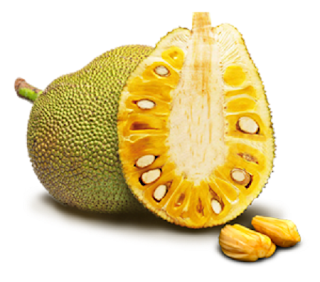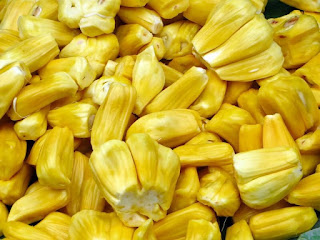Which
fruit is the largest tree fruit in the world, do you think you could
get the answer? Yes,
if u said Jackfruit, then u r right. Our own jackfruit. Jackfruit is
the largest known tree borne fruit. Even a small jackfruit weighs in
at 10-15lbs (5-7kg), and farmers have recorded specimens of more than
100lbs (45kg). Jackfruit
is believed to have originated in Southern India thousands of years
ago,
now
cultivated worldwide in the tropical regions of the Indian
subcontinent, Thailand, Malaysia, Indonesia and Brazil for its fruit,
seeds, and wood. The tree grows best in tropical humid and rainy
climates but rarely survives cold and frosty condition.
Jackfruit
is a huge tree that grows to as high as 30 meters, larger than mango,
breadfruit, etc. Jackfruit is recognized
for its unique shape, and size. it is also rich in energy, dietary
fiber, minerals, and vitamins and free from saturated fats or
cholesterol; fitting it into one of the healthy treats to
relish!Jackfruit consists of soft, easily digestible flesh (arils)
made up of simple sugars like fructose and sucrose. Seeds and green,
immature and unripe fruit employed as vegetable in many Asian
countries.
The word jackfruit comes from Portuguese jaca, which in turn, is derived from the Malayalam word chakka. For more precise, chakka is often referred to as the pre-ripe form and the ripe form is cas other names, too: kathal in Bangladesh, kanun in Thailand and nangka in Malaysia. The jackfruit is made up of hundreds or even thousands of individual flowers that are fused together. We eat the "fleshy petals" that surround the seed, which is the actual fruit.
Jackfruit is a true super-fruit: All the things from tree can used for various purposes. Almost everthing is useful. The unripe fruit must be cooked in order to eat it, but the ripe fruit is amazing raw. Jackfruits can be dried, roasted, added to soups, used in chips, jams, juices, ice cream. The seeds can be boiled, roasted or ground into flour. Even the tree itself is valuable: high-quality, rot-resistant timber for furniture and musical instruments. While the outer thick skin of the jackfruit is a much sought after feed for cattle, the leaves of the jackfruit tree are equally in demand by goat farmers. The orange bark has been used to dye the traditional robes worn by monks The trees produce a latex-like substance that can substitute for glue. Wood from the gigantic trees is also used for lumber.
The word jackfruit comes from Portuguese jaca, which in turn, is derived from the Malayalam word chakka. For more precise, chakka is often referred to as the pre-ripe form and the ripe form is cas other names, too: kathal in Bangladesh, kanun in Thailand and nangka in Malaysia. The jackfruit is made up of hundreds or even thousands of individual flowers that are fused together. We eat the "fleshy petals" that surround the seed, which is the actual fruit.
Jackfruit is a true super-fruit: All the things from tree can used for various purposes. Almost everthing is useful. The unripe fruit must be cooked in order to eat it, but the ripe fruit is amazing raw. Jackfruits can be dried, roasted, added to soups, used in chips, jams, juices, ice cream. The seeds can be boiled, roasted or ground into flour. Even the tree itself is valuable: high-quality, rot-resistant timber for furniture and musical instruments. While the outer thick skin of the jackfruit is a much sought after feed for cattle, the leaves of the jackfruit tree are equally in demand by goat farmers. The orange bark has been used to dye the traditional robes worn by monks The trees produce a latex-like substance that can substitute for glue. Wood from the gigantic trees is also used for lumber.
Besides
its high nutritional value, the fruit is very versatile. The seeds,
young fruit, and mature varieties are all edible. The timber from
jackfruit trees is also valuable. Jackfruit's
outer surface is covered with blunt spikes which become soft as the
fruit ripen. Its interior consists of eye-catching orange-yellow
color edible bulbs. Each bulb consists of sweet flesh (sheath) that
encloses a smooth, oval, light-brown seed. There may be as many as 50
to 500 edible bulbs embedded in a single fruit interspersed
in-between thin bands of fibers. Jackfruit seed encased inside a
thin, transparent outer cover. It largely composes of starch and
protein. Each seed measures about 2 to 4 cm in length, and 1 to 3 cm
in thickness.Almost all the parts of the tree secrete white sticky
latex-like milk (juice) upon infliction of injury.
As
a meat replacement, jackfruit
when
harvested young, is a low-calorie plant that has the look and texture
of real meat. By using jackfruit to replace meat in meals, you’ll
also cut back on negative environmental factors that many large-scale
farms unfortunately create: greenhouse gas emissions, animal cruelty,
and water usage. Harvesting
young jackfruit before it’s fully ripened, helps
in resembling meat like pulled pork or beef, because of its texture
and natural
sugars in the fruit have not yet developed. Next
time u taste it, please do feel it.. Yes,
Jackfruit does feel like, look like, and chew like meat.
Her are some of the Benefits of Jackfruit:
- It is easy to grow. It survives pests and diseases and high temperatures. It is drought-resistant.
- The fruit is rich in potassium, calcium, and iron, making it more nutritious than current starchy staples.
- Its anti-diabetic effect is due to its high constituent of flavonoid and proanthocyanidin. The sugar in Jackfruit is easily digestible and belongs to the category of Slowly Available glucose (SAG) whereby the glucose is gently released in the body thereby lowering its glycemic index. This suggests why this fruit is suitable for diabetic patients as it does not affect the blood glucose level.
- Jackfruit is essential for getting rid of unwanted toxins from the colon due to its high constituent of anti-oxidants. It is important to note that allowing these toxins to accumulate in the colon could possible result to colon cancer.
- The seeds are rich in thiamin and riboflavin which help in turning the food you eat into energy and keep your eyes, skin and hair healthy. The seeds also provide small amounts of minerals like zinc, iron, calcium, copper, potassium and magnesium.
- Jackfruit is a rich source of vitamin A, beta-carotene and lutein zeaxanthin which are essential for maintaining and promoting healthy vision. These vitamins protect the eyes against free scavenging radicals, viral infection and bacterial attacks that can lead to macular degeneration, night blindness, the risk of cataract and loss of sight.
- Jackfruit seeds contain compounds that have an antimicrobial effect, which could help prevent contamination with bacteria that cause food borne illnesses. These seeds have also been used in traditional medicine to help with digestive tract problems, although more research is necessary to verify these potential benefits.
- Jackfruit seeds contain lectins which have been scientifically proven to be effective against fungal attacks.
- Thanks to its large amount of potassium your blood will be controlled which will automatically reduce the chances of heart attack and stroke.
- It is one of the rare fruits that is rich in a B-complex group of vitamins. It contains outstanding amounts of vitamin B-6 (pyridoxine), niacin, riboflavin, and folic acid.
- Jackfruit is an excellent source of iron, vitamin K, vitamin C, vitamin E and vitamin A which are all essential for preventing anaemia and fighting against the deficiency of red blood cells in the blood. Jackfruit increases iron absorption with vitamin C in the body.
- In addition to bone-building magnesium, jackfruit contains calcium, which may help reduce the risk of In addition to bone-building magnesium, jackfruit contains calcium, which may help reduce the risk of osteoporosis or even osteopenia,which is the onset of osteoporosis.
- This fruit is rich in antioxidants. They are helpful in decreasing the aging, while the water included in jackfruit will make your skin moisturizer. It is also helpful against wrinkle.
Main
producers of jackfruit:
India
1.4 million tonnes (mt)
Thailand 0.39 mt
Indonesia 0.34 mt
Nepal 0.09 mt
The
jackfruit also provides a potential solution to countries facing
problems with food security, therefore called a miracle crop. This is a perennial fruit does not require replanting, nor does it require much
care, unlike other crops such as wheat or corn. It starts yielding
after 3-7 years of planting. Eventually, a yearly yield might be in
the 150- to 200-fruit range. Fruits are typically picked in summer
and fall. Jackfruit
is harvested straight from the tree. Jackfruit
could be a replacement for wheat, corn and other staple crops under
threat from climate change. Jackfruit,
despite its huge potential, remains underexploited as a food crop in
India, That is beginning to change, as new initiatives are taken to promote the crop by expanding its use as
a canned vegetable and as a processed food.The
effort coincides with a global push to expand food production,
especially in developing countries which are expected to face growing
challenges to feed their people in the coming decades.
Kerala,
the largest jackfruit producer in India, also wasted colossal amounts
of the fruit every year. This is even after exporting 50,000 tonnes
of the fruit annually to various places in North India,high cost of
labour and transportation cost may be the reason. Though there is
good demand, since there is no organized network and markets for
jack, they are left in the trees and spoiled.
In
India traditionally many products are made out of jackfruit. With
advancement in food and nutrition research, now there many commercial
products are available in the markets. Traditional foods are chips,
wafers, kadubu-a type sweet made of jack, chakka puzhuku, chakka varattiyath. Now we get jams, jellies,
ice creams made out of jackfruit. Jam, jelly, syrup, dry and frozen
jackfruits, Jackfruit Kabab, Jafi-Jackfruit coffee, Bar-B-Que Jack
are the recently added products. Now the
fruit is processed into products as diverse as flour, noodles, papad, pizza, tachos,sandwiches. Jackfruit is also canned and sold as a vegetable for
export. So many ways and we are not utilising it.
Jackfruits
are an excellent fruit with incredible health benefits. Above all it
can be used either as a vegetable or fruit ,All tree can be utilised.
Jackfruit is a nutritional boon to people in Vietnam, Malaysia and
Bangladesh, where it's the national fruitCountries like Thailand, the
Philippines and Sri Lanka have taken the jackfruit to the next level
by coming with value-added products. But what to change is the
ignorance given by people, If treated well jackfruit is definitely
going to be the next big thing on Indian dining tables soon. Giving
attention to the many attributes of jackfruit, organizing festivals
and advocating for more awareness of what the fruit could do is the
only way to help.



